International Journal of
eISSN: 2381-1803


Research Article Volume 17 Issue 6
1Department of Biochemistry, Faculty of Biosciences, Federal University Wukari, Taraba State, Nigeria
10Department of Pharmacy, Faculty of Pharmaceutical Science, Igbinedion University Okada, Edo State, Nigeria
11Department of Biochemistry, Faculty of Pure and Applied Sciences, Kwara state University Malete ,PMB 1530 Ilorin, 23431, Malete, Kwara State, Nigeria
12Federal Medical Centre Cancer Registry,Yenagoa Bayelsa State, Nigeria
13Department of Medical Biochemistry, College of Health Sciences Nile University of Nigeria, FCT, Abuja
14Department of Experimental Pharmacology and Toxicology, Faculty of Pharmaceutical Sciences, University of Port Harcourt. Rivers State. Nigeria
15Department of Immunology, Faculty of Basic Medical Sciences, College of Medicine, University of Ibadan, Nigeria
16Department of Biochemistry, Faculty of Basic Medical Sciences, University, of Lagos, Akoka, Nigeria
2Department of Biochemistry, Faculty of Biological sciences, University of Nigeria, Nsukka, Enugu State, Nigeria
3Department of Community, Environmental and Policy, Mel & Enid Zukerman College of Public Health, The University of Arizona, Tucson, AZ 85721, US
4Department of Biological and Environmental Sciences, Liverpool John Moores University, Byrom Street, Liverpool, L3 3AF United Kingdom
5Department of Biochemistry, Faculty of Sciences , University of Port Harcourt, East/ West Road, PMB 5323, Rivers State , Nigeria
6Department of Chemistry, Prairie View A&M University, Texas. 77446. United States of America
7Department of Public Health, Faculty of Epidemiology, University of Port Harcourt, Port harcourt Nigeria
8Association of public health in Ghana, Allied health professionals Council, Ghana
9Department of Biological Sciences, Faculty of Natural and Applied Sciences, Sule Lamido University Kafin Hausa, Jigawa State, PMB 048, Nigeria
Correspondence: Moses Adondua Abah, Department of Biochemistry, Faculty of Biosciences, Federal University Wukari, Taraba State, Nigeria
Received: November 24, 2024 | Published: December 11, 2024
Citation: Ife AV, Abah MA, Moranyo AE, et al. Effect of cucumis callosus fruit extract on the liver function of DMBA-induced mammary cancer in female albino wistar rats. Int J Complement Alt Med. 2024;17(6):255-261. DOI: 10.15406/ijcam.2024.17.00714
Breast cancer continues to be a significant health problem for women worldwide and remains one of the most common causes of cancer death in developed countries. In developing countries, the incidence of breast cancer has been trending upward and is becoming a major health burden also. This study aimed at investigating the effect of Cucumis callosus fruit extract on the liver function of 7, 12-Dimethylbenz[a]anthracene (DMBA)-induced mammary cancer in female rats. Thirty-six (36) healthy adult female wistar albino rats weighing about 150 to 200g were purchased. They were housed in polypropylene cages under the standard laboratory condition (25 ± 2°C, humidity 60-70 %, 12 hours light / dark cycles). The animals were fed with commercial rat pellet diet and water was provided ad libitum. The rats were acclimatized to laboratory conditions for one week prior to the commencement of the experiment. Cucumis callosus fruit was bought from Jimeta market in Yola, Adamawa state, Nigeria in November 2023. The pulp of fresh Cucumis Callosus fruits were chopped into pieces and dried at room temperature for 3 weeks. The completely dried fruit pulps were ground into powder by using a mortar and pestle then stored. 10 g of the dried fruit powder was successively extracted with 100 ml of methanol for 48hrs. Afterwards it was filtered with white mesh and then with Whatmann No 1 filter paper. The filtrate was concentrated using a rotatory evaporator. The concentrated extracts was stored in small vials and used for further analysis. The rats were organized into 5 groups: Rats in the control group (group 1) were fed with standard diet and water ad libitum. Rats in group 2 were induced with breast cancer by introducing into them 0.01% DMBA intravenously. Rats in group 3 were treated with standard drug and DMBA. Rats in group 4 were treated with DMBA and 100mg/b.wt, while rats in group 5 were treated with DMBA and 200mg/b.wt as treatment. After treatment for 3 weeks, the liver function marker enzymes levels of the rats such as Aspartate transaminase, Alanine transaminase, and alkaline phosphatase, among others were analyzed. The extract group showed similar levels of liver damage markers (AST and ALT) to the healthy control group, suggesting it might help maintain normal liver function despite the cancer. Total protein levels were not significantly affected by DMBA-induced breast cancer or the treatment plans. However, globulin levels showed significant differences, with higher levels in groups with Cucumis callosus extract. The study also found that a 100 mg/b.wt. dose of Cucumis callosus fruit extract may help maintain normal globulin levels in rats with DMBA-induced mammary cancer, but greater doses and conventional treatment regimens did not. The study suggests that Cucumis callosus extract, at a dose of 100 mg/b.wt, may offer protective effects on liver function in female rats with DMBA-induced mammary cancer.
Keywords: Breast cancer, 7, 12-dimethylbenz[a]anthracene (DMBA), enzymes, cucumis callosus liver
Breast cancer is the most common cancer among women both in developed and developing countries and a major cause of public health concern.1 While it exists around the globe, developed countries have a higher incidence rate and the incidence rate also varies by ethnicity and race.2 In Nigeria, breast cancer cases were historically low but are now increasing as a result of urbanization and lifestyle changes. Westernization of diet is one of the possible reasons for the increased incidence in developing countries. It is the leading cause of cancer deaths currently, representing about 23% of all cancer cases and approximately 18% of deaths are attributed to it in the country. The International Agency Research on Cancer (IARC) recorded 28,380 new Breast Cancer cases in Nigeria in 2020, representing 22.7% of new cancers and accounting for the highest proportion of all cancer types.3 Mortality from breast cancer may be influenced by economic and cultural factors to a different degree than incidence rate, as illustrated by comparing incidence rates to mortality rates. Similar trends are seen in comparisons of incidence rates and mortality rates for female populations from developed and developing countries around the world.4 Some of the risk factors of breast cancer are age, family history, genetic mutations, hormone replacement therapy, alcohol consumption, obesity, reproductive factors, and radiation exposure. Age is the most common risk factor, with most cases occurring in women over 50. Family history, particularly in first-degree relatives, can also increase the risk of breast cancer. Genetic mutations like BRCA1 and BRCA2 can significantly increase the risk.5
Cucumis Callosus, also known as the horned cucumber or kiwano, is a tropical fruit native to Africa, belonging to the Cucurbitaceae family. Its spiky exterior and vibrant orange-yellow skin make it a refreshing and tangy fruit. Leso et al.,6 reported that the premature fruit contains carbohydrate (9.31%), protein (0.48%), lipid (0.29%), and ash (0.93%). The plant has been reported to possess many bioactive components, such as flavonoids, alkaloids, steroids, terpenoids etc., which are secondary metabolites, possess healing activity and are used to cure several diseases.7 The plant has been used in traditional medicine to treat ailments like fevers, urinary tract infections, and stomach problems. Recent research has explored their potential therapeutic properties, including anti-inflammatory, antimicrobial, and anticancer effects. Cucumis Callosus, can be used as a spasmolytic and anesthetic agent due to the presence of alkaloid content, whereas appreciable amounts of saponins are helpful to boost immune system and lower the risks of various degenerative diseases. Total phenolic content has been reported to be between 56 and 72 μg GAE/mg extract in Cucumis Callosus.5
Researchers have studied the mechanisms of breast cancer development and test potential treatments and preventive strategies by exposing animals to DMBA. The metabolism of DMBA by cytochrome P450 enzymes in the liver forms reactive metabolites that bind covalently to DNA, forming DNA adducts.8 These adducts can cause mutations in critical genes involved in cell growth and proliferation, ultimately leading to cancer development. Studies have shown that DMBA-induced DNA adducts can activate oncogenes and inactivate tumor suppressor genes, promoting tumor formation. Additionally, DMBA exposure can induce oxidative stress and inflammation, further contributing to carcinogenesis. Treatment options for the management of breast cancer include surgery, radiotherapy, chemotherapy, hormonal therapy and immunotherapy. These treatment regimens have deleterious effects and patients have been observed to develop complications from such treatments.2 In Nigeria, access to breast cancer screening and treatment can be challenging due to limited resources, lack of awareness, and cultural barriers. However, there are ongoing efforts to improve access to breast cancer services in the country. This study sought to investigate the effect of Cucumis callosus fruit extract on the liver function of DMBA-induced mammary cancer in female rats.
Study area
The study was conducted at the Central Research Laboratory, Federal University Wukari, Taraba state, Nigeria, from October 2023 to March 2024.
Sample collection and extract preparation
The study utilized mature, fresh, healthy pulp of Cucumis Callosus fruits. The pulp of fresh Cucumis Callosus fruits were chopped into pieces and dried at room temperature for 3 weeks. The completely dried fruit pulps were ground into powder by using a mortar and pestle then stored. 10 g of the dried fruit powder was successively extracted with 100 ml of methanol for 48hrs. Afterwards it was filtered with white mesh and then with Whatmann No 1 filter paper. The filtrate was concentrated using a rotatory evaporator. The concentrated extracts was stored in small vials and used for further analysis (Figure 1).
Experimental animals
Thirty-six (36) healthy adult female wistar albino rats weighing about 150 to 200g were purchased. These rats were housed in polypropylene cages under the standard laboratory condition (25 ± 2°C, humidity 60-70 %, 12 hours light/dark cycles). The animals were fed with commercial rat pellet diet and water was provided ad libitum. The rats were then acclimatized to laboratory conditions for one week prior to the commencement of the experiment.
Treatment of animals
Thirty-six (36) healthy adult female wistar albino rats weighing about 150 to 200g were organized into 5 groups: The groups in which the rats were categorized into are as follows:
Group1: Standard diet + water only;
Group 2: Induced intravenously with 0.01% DMBA without treatment;
Group 3: Induced with 0.01% DMBA + treatment with standard drug;
Group 4: Induced with 0.01% DMBA + 100mg/b.wt Cucumis callosus fruit extract;
Group 5: Induced with 0.01% DMBA + 200mg/b.wt Cucumis callosus fruit extract.
After treatment for 3 weeks, the liver function marker enzymes levels of the rats such as Aspartate transaminase, Alanine transaminase, alkaline phosphatase, alongside other parameters were analyzed.
Induction of breast cancer
The solution induced in the rats was prepared by dissolving 7, 12-Dimethylbenz[a]anthracene (DMBA) in olive oil. The rats were allowed to acclimate to the laboratory environment for at one week before the experiment. Rats were administered a single dose of DMBA orally per body weight.
Liver function test
The serum samples of the rats were analyzed for various liver function parameters, including Aspartate Aminotransferase (AST), Alanine Aminotransferase (ALT), Alkaline Phosphatase (ALP), Total protein (TP), and Albumin (ALB) using a UV/ visible spectrophotometer.
Assessment of aspartate aminotransferase (AST) activity
Aspartate Aminotransferase activity in the serum samples was measured using the procedures described by Reitman and Frankel9. A Randox reagent kit was used for this analysis. The amino group was enzymatically transferred by AST present in the sample from L-aspartate to the carbon atom of 2-oxoglutarate yielding oxaloacetate and L-glutamate. AST activity was measured by monitoring the concentration of oxaloacetate hydrazone formed with 2, 4-dinitrophenylhydrazine. The reaction involved in the assay system is presented as follows:
L-Aspartate + + 2-Oxoglutarate AST Oxaloacetate + L-Glutamate
Assessment of alanine aminotransferase (ALT) activity
Alanine Aminotransferase activity in the serum samples was investigated using the method described by Reitman and Frankel9 using a Randox reagent kit. The amino group was enzymatically transferred by ALT present in the sample from alanine to the carbon atom of 2-oxoglutarate yielding pyruvate and L-glutamate. The reaction involved in the assay system is presented as follows:
L-Alanine + 2-Oxoglutarate ALT Pyruvate + L-Glutamate
Assessment of alkaline phosphatase (ALP) activity
Alkaline Phosphatase serum activity in the serum samples was assessed using the Agappe reagent kit, following the procedure by Schlebusch et al.,10 Colorimetric determination of alkaline Phosphatase activity was according to the following reaction: The phenol liberate was measured in the presence of 4-aminoantipyrine and potassium ferricyanide. The presence of sodium arsenate in the reagent stopped the enzymatic reaction. The reaction involved in the assay system is presented as follows:
Phenylphosphate ALP Phenol + Phosphate
pH 10
Determination of total protein (TP)
Randox reagent kit was utilized to determine the total protein concentration following the method outlined by Ayo et al11.In alkaline medium copper reacted with the peptide bonds of proteins to form the characteristic pink to purple biuret complex. Sodium potassium tartarate prevented copper hydroxide precipitation, and potassium iodide prevented the autoreduction of copper. The color intensity which is directly proportional to the protein concentration was determined by measuring the increase in the absorbance at 546nm. The reaction involved in the assay system is as follows:
Protein + Cu2+ Alkaline pH Cu – protein complex
Determination of albumin (ABL)
Agappe kit was used to determine the serum albumin concentration following the method described by Doumas et al12. Measurement of albumin was based on its binding to the indicator dye bromocresol green (BCG) in pH 4.1 forming a blue-green colored complex. The intensity of the blue-green color was directly proportional to the concentration of albumin in the sample. It was determined by monitoring the increase in absorbance at 623 nm, or 578 nm. The reaction involved in the assay system is as follows:
Albumin + BCG pH 4.1 Albumin-BCG Complex
Estimation of globulin (GLB)
The estimation of globulin was performed using the formula provided below:
Globulin = Total protein – Albumin
Determination of total bilirubin (TB)
The estimation of Total Bilirubin was performed using the formula provided below:
Total Bilirubin (TB) = Direct Bilirubin + Indirect Bilirubin (IDB)
Statistical analysis
The obtained biochemical results were analyzed statistically using One-Way Analysis of Variance (ANOVA), and post hoc least-significant difference (LSD) test using Statistical Package for Social Science (SPSS). Significance between means was determined at a p-value of less than 0.05 (p<0.05). The results for each treatment were presented as mean ± standard deviation
Effect of cucumis callosus fruit extract on the liver function of DMBA-induced mammary cancer in female albino wistar rats
Administration of plant extract for 100mg/b. wt and 200mg/b. wt i.e GROUP 4 and 5 increased the serum AST significantly (p<0.05), compared to normal control, negative control and standard drug. Serum ALT and ALP activities were increased significantly (p<0.05) in all the test groups compared to normal control, negative control and standard drug. Total protein was increased significantly (p<0.05) in GROUP 5 unlike GROUP 4 where no significant increase. Albumin was increased significantly (p<0.05) upon administration of 100mg/b. wt and 200mg/b. wt. Globulin was lowered significantly (p<0.05) upon administration of 100mg/b. wt, administration of 200mg/b. wt did not show significant effect on serum albumin compared to normal control. Total bilirubin and direct were elevated significantly (p<0.05) in all the test groups compared to normal control, negative control and standard drug. Indirect bilirubin were affected significantly (p<0.05) upon administration of 100mg/b. wt, administration of 200mg/b. wt did not show significant effect compared to normal control.
Effect of cucumis callosus fruit extract on serum aspartate transaminase concentration of DMBA-induced mammary cancer in female albino wistar rats
Figure 2 shows the result of Aspartate Transaminase concentration obtained in the 5 groups of rats used in this study. The result obtained projects that the serum AST concentration was lowest in the control group (14.29±0.38) compared to other groups. Group 2 which represents the set of rats induced 0.01% DMBA without treatment showed the highest concentration serum AST (37.35±0.86). It was also observed that AST concentration differed significantly (p<0.05) across group 1 to group 5. AST level was significantly (p<0.05) reduced upon administering 200mg/b.wt Cucumis callosus fruit extract to rats induced with 0.01% DMBA compared to the sets of rats induced with 0.01% DMBA without treatment (37.35±0.86), 0.01% DMBA + treatment with standard drug (28.44±1.27), and rats induced with 0.01% DMBA + 100mg/b.wt Cucumis callosus fruit extract (24.88±1.09).
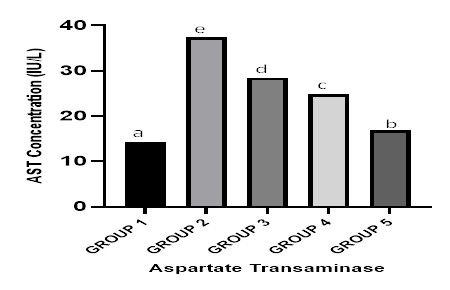
Figure 2 Effect of Cucumis Callosus fruit extract on serum AST concentration of DMBA-induced mammary cancer in female albino wistar rats.
* AST= Aspartate transaminase
Effect of cucumis callosus fruit extract on serum alanine transaminase concentration of DMBA-induced mammary cancer in female albino wistar rats
The result obtained upon investigating the effect of Cucumis Callosus fruit extract on serum Alanine Transaminase concentration of DMBA-induced mammary cancer in female albino wistar rats is presented in Figure 3. Administration of Cucumis Callosus fruit extract to group 4 and group 5 rats significantly (p<0.05) decreased their serum ALT concentration (29.00±0.78 and 21.10±0.31 respectively) compared to group 2 rats that were induced with 0.01% DMBA without administering any treatment (48.14±1.32) and group 3 rats that were administered a standard drug following induction (33.48±1.34). It was also observed that rats in the control group had the lowest serum ALT concentration (17.02±0.11) compared to all the other groups.
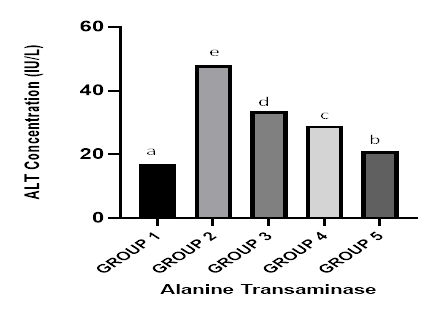
Figure 3 Effect of Cucumis Callosus fruit extract on serum ALT concentration of DMBA-induced mammary cancer in female albino wistar rats.
*ALT= Alanine transaminase
Effect of cucumis callosus fruit extract on serum alkaline phosphatase concentration of DMBA-induced mammary cancer in female albino wistar rats
The result presented in Figure 4 reveals serum Alkaline Phosphatase concentration obtained in the 5 groups of rats used in this study. The result obtained showed that the concentration of serum ALP was lowest in the control group (89.71±0.87) compared to all other groups. Group 2 which represents the set of rats induced 0.01% DMBA without treatment showed the highest concentration of serum ALP (177.03±0.06). It was also observed that serum ALP concentration differed significantly (p<0.05) across group 1 to group 5. Serum ALP concentration was significantly (p<0.05) decreased (100.94±1.94) upon administering 200mg/b.wt Cucumis callosus fruit extract to rats induced with 0.01% DMBA compared to the sets of rats induced with 0.01% DMBA without treatment (177.03±0.06), 0.01% DMBA + treatment with standard drug (154.58±1.23), and rats induced with 0.01% DMBA + 100mg/b.wt Cucumis callosus fruit extract (132.78±0.28).
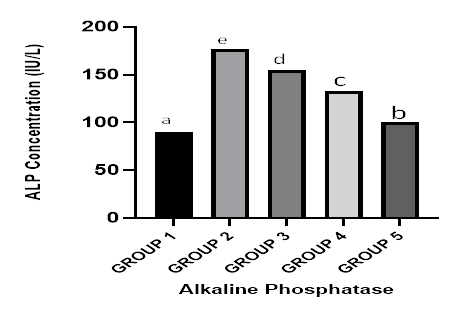
Figure 4 Effect of Cucumis Callosus fruit extract on serum ALP concentration of DMBA-induced mammary cancer in female albino wistar rats.
*ALP= Alkaline phosphatase
Effect of Cucumis Callosus Fruit extract on Serum Total Protein concentration of DMBA-Induced Mammary Cancer in Female Albino Wistar Rats
The result obtained upon investigating the effect of Cucumis Callosus fruit extract on serum Total Protein concentration of DMBA-induced mammary cancer in female albino wistar rats is presented in Figure 5 below. The result revealed that total protein concentration decreased significantly (p<0.05) in group 2 rats upon 0.01% DMBA without treatment upon inducing them with 0.01% DMBA without treatment. Compared to all other groups, rats in group 2 were observed to have the least concentration of total protein (6.85±0.13). Upon treating group 3 rats with standard drug and group 4 and group 5 rats with 100mg/b.wt and 100mg/b.wt Cucumis callosus fruit extract respectively, total protein concentration in these groups increased significantly (p<0.05).
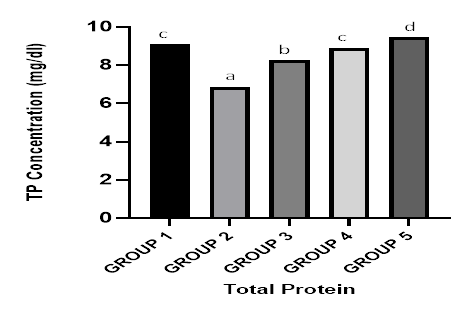
Figure 5 Effect of Cucumis Callosus fruit extract on serum TP concentration of DMBA-induced mammary cancer in female albino wistar rats.
*TP= Total protein
Effect of cucumis callosus fruit extract on serum albumin concentration of DMBA-induced mammary cancer in female albino wistar rats
The result presented in Figure 6 reveals serum Albumin concentration obtained in the 5 groups of rats used in this study. The result obtained showed that the concentration of serum albumin was lowest in group 3 experimental animals (5.11±0.03) compared to all other groups whereas, group 4 experimental animals showed the highest concentration of serum albumin (6.47±0.16) compared to all other groups. Experimental animals induced intravenously with 0.01% DMBA without treatment with standard drug (5.94±0.03) showed no significant difference (p<0.05) in serum albumin concentration with experimental animals induced with 0.01% DMBA + 200mg/b.wt Cucumis callosus fruit extract (5.85±0.04).

Figure 6 Effect of Cucumis Callosus fruit extract on serum ALB concentration of DMBA-induced mammary cancer in female albino wistar rats.
*ALB= Albumin
Effect of cucumis callosus fruit extract on serum globulin concentration of DMBA-induced mammary cancer in female albino wistar rats
The result obtained upon investigating the effect of Cucumis Callosus fruit extract on serum Globulin concentration of DMBA-induced mammary cancer in female albino wistar rats is presented in Figure 7 below. The result revealed that group 1 experimental rats showed the highest concentration of serum globulin (3.78±0.08) compared to all other experimental groups. However, no significant difference (p<0.05) was observed in the serum globulin concentration of group 1 experimental rats and group 5 experimental rats induced with 0.01% DMBA + 200mg/b.wt Cucumis callosus fruit extract (3.62±0.70). Upon inducing group 2 experimental rats with 0.01% DMBA without treatment with standard drug, their serum globulin concentration decreased significantly (p<0.05) making them to have the lowest concentration of serum globulin (0.91±0.11) compared to all other experimental groups. A significant difference in the concentration of serum globulin was observed between group 3 experimental rats induced with 0.01% DMBA + treatment with standard drug (3.17±0.06) and group 4 experimental rats induced with 0.01% DMBA + 100mg/b.wt Cucumis callosus fruit extract (2.41±0.32).
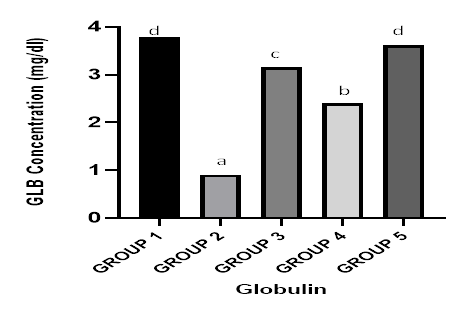
Figure 7 Effect of Cucumis Callosus fruit extract on serum GLB concentration of DMBA-induced mammary cancer in female albino wistar rats.
*GLB= Globulin
Effect of cucumis callosus fruit extract on serum total bilirubin concentration of DMBA-induced mammary cancer in female albino wistar rats
The result obtained upon investigating the effect of Cucumis Callosus fruit extract on serum Total bilirubin concentration of DMBA-induced mammary cancer in female albino wistar rats is presented in Figure 8 below. The result revealed that group 1 experimental rats showed the lowest concentration of serum total bilirubin (3.49±0.08) compared to all other experimental groups. But following intravenous induction of 0.01% DMBA without treatment for group 2 experimental rats, their serum total bilirubin concentration increased significantly (p<0.05), making them the group with the highest concentration of serum total bilirubin (6.02±0.05). A progressive and significant decrease in serum total bilirubin concentration was observed from group 3 experimental rats through group 5 experimental rats in the order presented as thus: group 3 (5.09±0.02) > group 4 (4.58±0.08) > group 5 (3.79±0.04).
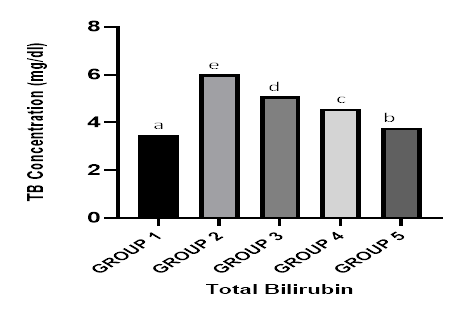
Figure 8 Effect of Cucumis Callosus fruit extract on serum TB concentration of DMBA-induced mammary cancer in female albino wistar rats.
*TB= Total bilirubin
Effect of cucumis callosus fruit extract on serum direct bilirubin concentration of DMBA-induced mammary cancer in female albino wistar rats
The result obtained upon investigating the effect of Cucumis Callosus fruit extract on serum Direct bilirubin concentration of DMBA-induced mammary cancer in female albino wistar rats is presented in Figure 9 below. The result revealed that group 1 experimental rats showed the lowest concentration of serum direct bilirubin (3.08±0.06) compared to all other experimental groups. But following intravenous induction of 0.01% DMBA without treatment for group 2 experimental rats, their serum direct bilirubin concentration increased significantly (p<0.05), making them the group with the highest concentration of serum direct bilirubin (4.90±0.01). A progressive and significant decrease in serum direct bilirubin concentration was observed from group 3 experimental rats through group 5 experimental rats in the order presented as thus: group 3 (4.32±0.04) > group 4 (3.83±0.06) > group 5 (3.29±0.01).
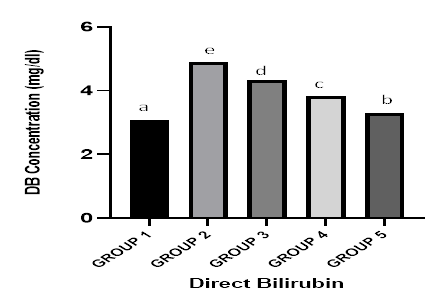
Figure 9 Effect of Cucumis Callosus fruit extract on serum DB concentration of DMBA-induced mammary cancer in female albino wistar rats.
*DB= Direct bilirubin.
Effect of cucumis callosus fruit extract on serum indirect bilirubin concentration of DMBA-induced mammary cancer in female albino wistar rats
Figure 10 shows the result of serum Indirect Bilirubin concentration obtained in the 5 groups of rats used in this study. The result obtained projects that serum indirect bilirubin concentration was lowest in the control group (0.41±0.02) compared to other groups. Group 2 which represents the set of rats induced 0.01% DMBA without treatment showed the highest concentration serum indirect bilirubin (1.12±0.06). A progressive in serum indirect bilirubin concentration was observed from group 3 experimental rats through group 5 experimental rats in the order presented as thus: group 3 (0.78±0.06) > group 4 (0.75±0.03) > group 5 (0.49±0.06). However, it was observed that there was no significant difference in serum indirect bilirubin concentration between experimental rats induced with 0.01% DMBA + treatment with standard drug and those induced with 0.01% DMBA + 100mg/b.wt Cucumis callosus fruit extract.
Breast cancer is the most common malignancy in young women (20–39 year of age) worldwide.13 In Nigeria precisely, some 100 000 new cases of cancer occur every year, with high case fatality ratio.14 With approximately 20% of the population of Africa and slightly more than half the population of West Africa, Nigeria contributed 15% to the estimated 681,000 new cases of cancer that occurred in Africa in 2008.3 Chemically induced rat models of mammary cancer have been extensively used over the years to emulate human breast carcinogenesis. Rat tumors are not extremely invasive beyond the mammary fat pad, have short latency, seldom metastasize and are highly hormone-dependent and for that reason were widely used as models of estrogen dependent breast cancers.15
The present study investigated the effect of Cucumis callosus fruit extract on the liver function of 7, 12-Dimethylbenz[a]anthracene (DMBA)-induced mammary cancer in female rats. It was found out that upon inducing group 2 rats with 0.01% DMBA without treatment with the standard drug, serum AST concentration increased significantly compared to the control. This observation could be due to the effect of tissue injury and impaired cell membrane integrity resulting cytoplasmic leakage of enzymes into the blood stream, this could be reasoning for persistent liberation of those enzyme into serum. This finding is consistent with that of Akhouri et al.,14 who also observed an increase in the concentration of serum AST orchestrating DMBA-induced mammary cancer in rats.
The result obtained upon investigating the effect of Cucumis Callosus fruit extract on serum Alanine Transaminase concentration of DMBA-induced mammary cancer in female albino wistar rats showed that administration of Cucumis Callosus fruit extract to group 4 and group 5 rats significantly (p<0.05) decreased their serum ALT concentration. This suggests that Cucumis Callosus fruit extract would have reversed tissue damage through maintaining the membrane integrity, permeability and minimizing enzyme leakage. This result is in tandem with the findings of Jamdade et al.,16 and Kumar et al.,17 who both observed decline in the concentration of serum ALT in cancer-induced rats upon introducing a standard drug to them.
The study also investigated the effect Cucumis Callosus fruit extract on Alkaline Phosphatase concentration of DMBA-induced mammary cancer in female albino wistar rats. The finding here was that, the set of rats induced 0.01% DMBA without treatment showed the highest concentration of serum ALP indicating that DMBA would have caused liver injury by impairing its cell membrane integrity resulting cytoplasmic leakage of enzymes into the blood stream. It was also observed that serum ALP concentration was significantly (p<0.05) decreased upon administering 200mg/b.wt Cucumis callosus fruit extract to rats induced with 0.01% DMBA compared to the sets of rats induced with 100mg/b.wt Cucumis callosus fruit extract following DMBA induction. This suggests that higher dose of Cucumis callosus fruit extract functions better by declining the concentration of serum ALP. Liver enzymes such as ALT, AST, and ALP are proteins produced by your liver. They are essential for various body processes, such as digestion and cellular metabolism. It has been reported that persistently elevated liver enzymes can be caused by certain types of cancer.18
Circulating levels of liver function markers like TP, GB, ALB, IDB, DB, and TB above normal ranges could be associated with cancer. The current study observed that direct and indirect serum bilirubin and total bilirubin increased significantly (p<0.05) in the serum of rats induced with in the 0.01% DMBA. This was not so for liver markers like total protein, globulin, and albumin. The elevation of TB, IDB, and DB concentration could be as a result of the oxidative metabolism of DMBA which has been implicated in the production of Reactive Oxygen Species that are capable of generating free radicals and depletion of antioxidants leads to peroxidation of membrane lipids resulting in liver injury.19 This observation is consistent with the findings of Faheem et al20.The aforementioned biochemical markers enzymes serve as a useful indicator for prognosis prediction and understanding the metastasis of breast cancer.14 The abnormalities in their activities are considered to be a good correlation with the number of transformed cells in cancer conditions of rodents which presumed by the action of tissue damaged thereby primarily leakage of pathophysiological enzymes from cytosol into blood stream.21–23
The results of the study showed that the administration of Cucumis Callosus fruit extract had a significant protective effect on liver function parameters in rats with DMBA-induced breast cancer. Specifically, levels of liver enzymes such as alanine transaminase (ALT) and aspartate transaminase (AST) were found to be significantly lower in rats treated with Cucumis Callosus fruit extract compared to those in the control group. Additionally, markers of liver damage such as total bilirubin and alkaline phosphatase were also reduced in the treatment group. Overall, these findings suggest that Cucumis Callosus fruit extract may have a beneficial effect on liver function in the context of breast cancer treatment. Further research is needed to elucidate the underlying mechanisms responsible for these effects and to determine the potential clinical implications for human patients.
We acknowledge Dr. Victoria for conceptualizing the idea of this research and all other coauthors for their participation.
All authors declare that they have no conflict of interest associated with this research article.
No special funding was received for this research work.

©2024 Ife, et al. This is an open access article distributed under the terms of the, which permits unrestricted use, distribution, and build upon your work non-commercially.